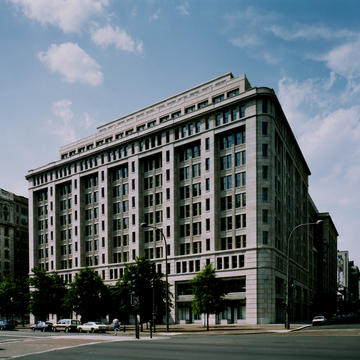This office building exhibits the best of new construction along the nation's ceremonial thoroughfare. The developers, Cadillac-Fairview, with the architects, Hartman-Cox, were challenged by the location to produce a new building that would be in keeping with the Federal Triangle across the avenue, the Evening Star Building (see DE24) to the west, and the FBI Building (see DE22) to the east, while at the same time retaining several small brick facades at the northwest corner of the building.
The building is sheathed in limestone and brick. The Pennsylvania Avenue facade features projecting one-bay pilasters punched with windows and deeply recessed sections four bays wide. Vertically, the building is divided into a base, shaft, and capital, echoing the typical American office building of the early twentieth century. The rear of the building, however, steps down in sections to meet the old brick facades. Although the retention of these facades can be criticized as mere tokens to preservation, as venerable fragments they lend variety to the design of the building. A distinctive interior feature is the seven-story octagonal atrium that connects with each of the entrances.














